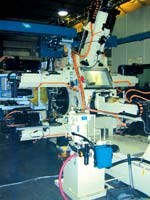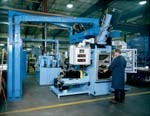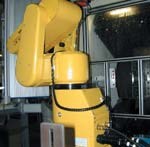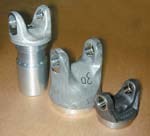Trunnion Machines In Transition
CNC may bring trunnion systems to a generation of contract manufacturers unfamiliar with this type of machine.
There is a danger in assuming that any established approach to machining has been eclipsed by a more recent technology. The danger lies in declaring victory too soon. The old technology continues to improve just like the newer technology does. That improvement may make the old way new again.
Consider the production of automotive parts that begin as castings or forgings, and similar high volume machining applications. One trend in recent years has been a move away from dedicated transfer systems toward machining these parts on CNC lathes and machining centers. More capable and less costly CNC has made these standard machines faster, more accurate and less expensive, while the inherent flexibility of these machines results in a process that is easy to reconfigure as production quantities or part designs change.
However, the same advances in CNC also make it cost effective to apply this control to the many axes of motion in a transfer system. Doing so combines the productivity of transfer machining with some of the adaptability and ease of use typical of a CNC machine. As a result of this and other improvements, today's "dedicated" machining systems are not nearly so inflexible as they used to be.
One example of current transfer machining technology comes from machine builder CityMachine of Muncie, Indiana. The company makes CNC trunnion-type rotary transfer systems.
Bob Haack is a company vice president. He says getting one of these machines into an application well suited to it almost always involves a learning process. Prospective users familiar with established trunnion-type designs often are unaware of how CNC changes these machines. Meanwhile, outsourcing has sent potential trunnion machine work to contract shops that have never dealt with such high volumes before. Standard machining centers and lathes are what these shops know best, and in many cases, they are unaware that something like a trunnion-type machine is a viable alternative.
Up And Down Indexing
Rotary transfer machines move parts from station to station around a ring. In general, loading and unloading occur at one station, while machining—or some related operation such as gaging—occurs at all of the other stations. Each station addresses a different workpiece at a different stage in the sequential progression. Because all of the stations are working on pieces simultaneously, every move from one station to the next delivers a new piece ready for unloading to the load/unload station.
The word "trunnion" suggests the direction of the rotary transfer. The original trunnion is the pin about which a cannon pivots up and down. In a trunnion-type machine tool, the trunnion is the horizontal shaft around which the workpieces index up, down or across. (See Figure 1.) Another variety of rotary transfer is that of the dial-type machine, which indexes parts horizontally. These two types of machines both move stationary workpieces around a circle from one machining spindle to the next, but the dial machine moves parts like a merry-go-round while the trunnion machine moves them like a Ferris wheel.
Mr. Haack describes some advantages of the vertical indexing. One is chip control. Similar to horizontal machining centers, trunnion machines can rely on gravity to do much of the work of getting chips out of the way of the cut.
Another advantage is that the trunnion configuration permits easy access to three different faces of the part. At a given station, CNC axes can reach a radial face and two axial faces. (See Figure 2.) A dial-type configuration (which has the floor and the base of the machine directly below the work) presents design challenges to reaching one of these axial faces.
A third advantage relates to floor space. Much of a trunnion machine's space demand is vertical. The actual footprint is relatively small compared to what a comparable machine indexing horizontally would require. The footprint can be very small compared to what a competing group of standard machine tools would require. In the case of one CityMachine customer, says Mr. Haack, the electronics cabinet for the trunnion machine was placed on a mezzanine for even greater floorspace savings.
CNC brings additional benefits to these machines. The most obvious is programmability. If two related parts are so similar that they can share the same tooling and workholding, then simply calling up a different program for the CNC axes is enough to change over from one part number to the next.
But a more significant CNC advantage comes into play when a change of tooling is required. Earlier trunnion machines designed for hydraulic actuation limited the access to tools from outside the work zone. Tools were difficult to change. But ballscrew-driven axes moving along sliding ways overcome this limitation; it's easy to back these axes out of the machine so the operator can reach the tool. (See Figure 3.) In fact, the cutters lower down on the machine are so accessible that it's easier to change one of these tools than it is to change a tool on some standard CNC lathes. Mr. Haack believes this one design improvement accounts for most of the success CityMachine has had with finding new applications for these machines.
Where They Work
The trunnion-type systems start to make economic sense at about 500,000 parts per year, he says. With outsourcing sending more jobs of this size to smaller manufacturers, the market for these machines is going there too. Experience with smaller volumes gives these shops familiarity with standard lathes and machining centers. However, applying standard machines to a high-volume job can present problems related to both land and labor. The shop needs to find floor space for all of the machines and enough operators to run them. Workhandling automation may reduce the number of operators needed, but this solution tends to increase the floorspace demands. By contrast, a trunnion-type system directly addresses both concerns. Its space demand is vertical, and it requires only one operator.
Figure 4 illustrates a family of parts formerly produced using standard machines. The trunnion machine in this application replaced two lathes and a cross-hole drilling and boring machine. A far more extreme example of machine consolidation comes from an application CityMachine is currently bidding on. In that job, productivity comparable to the trunnion machine would require 12 lathes and four machining centers.
The rotary transfer machine may also streamline quality control. When standard machines are used for high volume work, parts often flow through parallel stations or processes. The redundancy allows production to continue when one flow path is interrupted for service, but it can make quality problems difficult to track. If any parts are bad, for example, which of three redundant lathes is at fault? Or which of 24 positions on a tombstone fixture? Rotary transfer makes the cause of any errors easy to identify, because every part moves from station to station in a single unvarying sequence. In fact, this sequence can also include gaging where very precise dimensional control is needed. Measuring a feature at one station can allow the CNC to compensate when a cut at another station is trending out of control limits. (See Figure 5.)
Precision as much as productivity accounts for why trunnion-type systems are chosen, Mr. Haack says. Many users serve the automotive industry, where accuracy requirements continue to constrict. Truck parts, for example, once went into vehicles intended to do work, but now they go into SUVs that are expected to deliver a smooth ride at highway speeds. Shrinking tolerance bands reflect this shift. A trunnion-type system helps the manufacturer hold these tolerances by reducing part handling. Within the rotary transfer machine, a single chucking carries the part to every station. If the feature held in the chuck doesn't have to be machined, then the single chucking is enough to machine the part complete.
And in the case of at least one machining operation, the CNC trunnion-type system is far more productive than a more standard machine tool. That operation is deep hole drilling.
When a machining center is used for the kinds of holes that might otherwise be gun drilled, the hole is machined in stages. An unsupported long drill would be too unstable to use for the entire hole, so the machining center begins with a more rigid shorter drill and proceeds to greater depths with progressively longer tools. Prior to each new tool is a tool change.
The CNC trunnion-type system uses the same sequence of drills, and it uses the travels in its sliding ways to make moves comparable to the drilling moves of the machining center. The difference is that the trunnion machine uses all of these tools at once and makes all of these moves simultaneously. During the time between each rotary index, a new deep hole is machined. That's faster than the machining center can do the job. It's likely to be faster than the gun drilling machine as well.
Read Next
3 Mistakes That Cause CNC Programs to Fail
Despite enhancements to manufacturing technology, there are still issues today that can cause programs to fail. These failures can cause lost time, scrapped parts, damaged machines and even injured operators.
Read MoreThe Cut Scene: The Finer Details of Large-Format Machining
Small details and features can have an outsized impact on large parts, such as Barbco’s collapsible utility drill head.
Read More




.bmp;width=860)












.png;maxWidth=300;quality=90)












